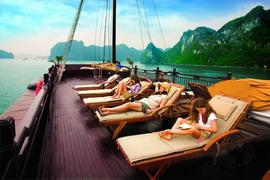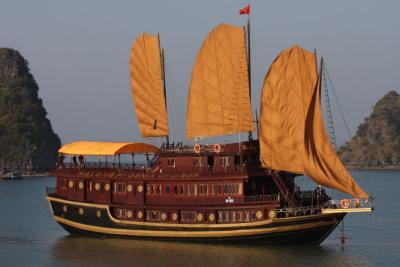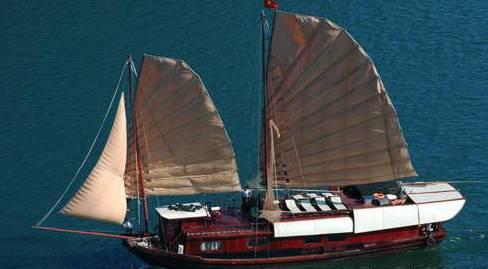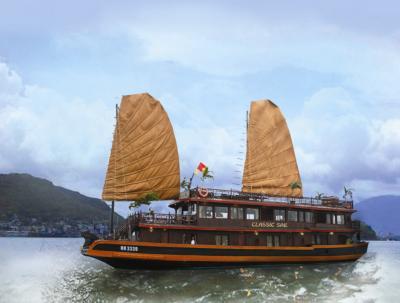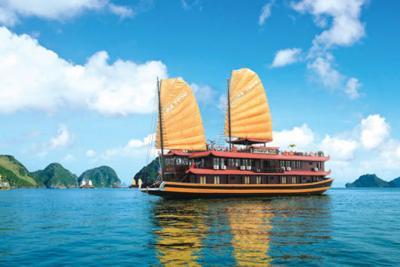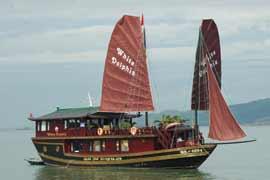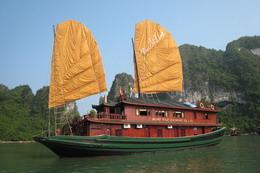|
It’s
a strange land that leaves me with different feelings whenever I come to
rediscover it.
 | | Steps to heaven: The
familiar terraced fields in Sa Pa attract many domestic and foreign visitors.
(Photos: VNS) | Sa Pa is
an incredibly picturesque town in the Hoang Lien Son Mountain Range near the
Chinese border in northwestern Viet Nam, 350km from Ha Noi. It can
be explored almost year-round from March to early December. Vietnamese most like
to visit during June and July to escape the summer heat in other parts of the
country. Sa Pa is 1,500m above sea level so the weather is quite mild, and cold
at night. The best
time to go to Sa Pa is on a weekday, as weekenders tend to flock here. However,
the famed “love market” only takes place on Saturday nights, so visitors often
extend their tour to Saturday to experience it. Tourists
can see many hill tribe people, their villages and rice terraces. The ethnic
minority groups generally retain their lifestyles and traditional costumes. The
area’s high mountains, deep ravines and lush vegetation rise to the peak of Mt
Fansipan – the highest point in Indochina. The combination of fresh mountain
air, relaxed ambience, sweeping panoramas and fascinating hill tribes make Sa Pa
a must-see destination. A trek
took us deep into a hill tribe region where tourists are still something of a
novelty. Staying in village homes allowed us to experience firsthand a lifestyle
that has been little touched by the modern world and a curiosity from our hosts
just as great as our own. The trekking is fairly strenuous at times but the
spectacular scenery and sense of adventure make it worth the effort.
 | | Gracious guides: Many
local women work as souvenir sellers and tour guides to lead tourists to
discover their hometown’s lifestyle and hidden charm. | I can’t
explain why all of the local tour guides are women. All are under 30 and haven’t
yet married. Thao Thi Ru, a Dao ethnic woman, has guided tourists since she was
12, after starting her career as a souvenir vendor. Sometimes, to get tourists
buy her hand-made souvenirs, she has offered herself as a guide for free.
Gradually, she has learned English from them, learned to cook dishes to their
tastes, and acquired the experience to become a professional tour guide. “Being
local, we have an advantage over tour companies,” Ru said. “Foreign tourists
prefer us to guide them because we know the ways and easily lead them to
villages and local houses. They love to understand the local customs as told by
locals like us.” Under
Ru’s direction, we visit Ta Van, Ta Phin and Ban Ho communes and get a greater
understanding of the Mong and Dao people’s stone-carving, weaving,
jewelry-making, metalwork and embroidery crafts. Ta Phin
Cave, at the far end of Ta Phin village, is an attractive destination which
tourists often bypass without a local guide’s suggestion. The cave
requires a guide with a flashlight, and the guide will shine the torch on a
variety of stalactites. Some of
the locals invite visitors to go to their homes to show how they live and what
they have, and tell them about their families. On following them to their
houses, tourists find out how simply they live. The tour guides suggest you to
buy the merchandise you like from them as repayment for what they have shown for
you.
 | | Bridging the divide: A
foreign tourist tries to cross the May (Rattan or Cloud) Bridge in Sa Pa, a
destination for adventurous tourists. | Local
tour guides also lead the trips to the forests and mountains because they know
thoroughly the terrain. Before
starting a tour, the guides remind tourists to bring cooking, shoes, sleeping bags
and other necessities, said Giang Thi Co, a Mong woman. “I have
learned from the elders folk medicines to treat stomach aches, muscle pains and
snake bite,” Co said. “Once, a Western woman couldn’t walk anymore because her
legs were sore, so I picked some leaves to apply to her swollen calves. She felt
better and said ‘good, good!’ to me.” City
lovers may find Sa Pa is not the place for them as its rich ethnic lifestyle is
far removed from modern life. If you expect to go shopping in malls, Sa Pa has
nothing to offer. The only way to go shopping is to go to the local market where
you can find unique handicrafts, jewelry and fabrics with colourful embroidery.
While tourists don’t know how to bargain or choose the best items, the local
guides are ready to help. Sa Pa is
famous for its “love market” where local young people go to show off and find
partners. It is held every Saturday night and provides a unique and
unforgettable experience. The love
market is a tradition in the culture of the Mong, Tay and Dao. All the people
around Sa Pa live in isolated villages and can only get together once a week
during the Sunday morning market. The night before, young men and women from all
around come to the love market to meet and express their emotions through
playing the khen (pan pipe) and singing according to traditional customs of
their people. The
experience of Sa Pa trip is not something that everyone can buy, but adventurous
people and those who seek to know the hidden charm of Vietnamese hill tribes
living in their old traditional mountain villages cannot miss this place. VietNamNet/Viet
Nam News | 



